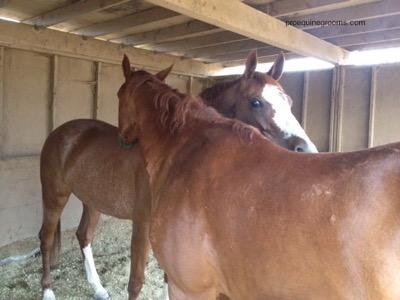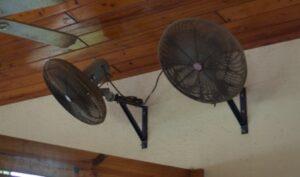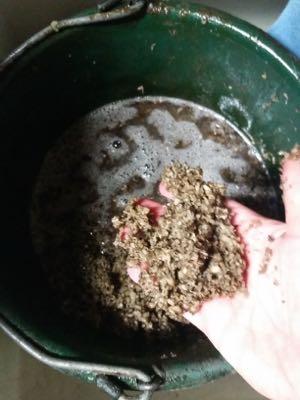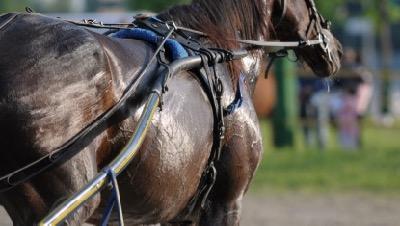37 Ways to Help Your Horse Beat the Heat
Ah, the dog days of summer. Lots of sunlight, school’s out, and everything is HOT and HUMID. This weather can sometimes create problems for horses (and people), and there are many things you can do. You are probably doing some of these things to stay cool. Here are some ways horse owners can help their horses beat the heat.
Table of Contents

These two lovebirds are enjoying some shade on a hot day.
Food and Water Adjustments in Hot Weather
- You can adjust your horse’s diet to help them stay cool in hot temperatures while boosting their hydration levels. Many of these things are everyday chores, but in the summer months, they may require more attention.
Water
- Add more clean water sources. More water locations mean herd horses are less likely to be pushed out.
- Move existing watering stations into the shade.
- Change your horse’s water more frequently – mosquito larvae may be growing.
- And monitor troughs for algae. You may need to clean buckets more often.
- Track how much water your horse drinks as best you can. Some automatic waterers have accessories to measure consumption, and you reset the gauge daily. Horses require gallons of water daily, sometimes as much as 10 to 20 gallons.
- Offer your horse flavored water to encourage them to drink. Add electrolytes, a small amount of feed, or a flavored sports drink to some water. Always make this an option in addition to unflavored, in case your horse doesn’t appreciate your bartending skills.
- Horses are known to prefer ice water over warm water, but will drink more warm water. You can tempt a horse to drink the cold water by offering it alongside the warm water if you need your horse to drink.
Vitamins, minerals, and electrolytes
- Add electrolytes to your horse’s feed instead of offering blocks. Mineral blocks are unbalanced for horses, and the texture suits a cow’s tongue. Horses won’t ingest their daily recommended quantities.
- Loose salt in their feed is better than a white salt block, mostly because you can’t trust a horse to give themself the proper amount per day.
- Consult with your veterinarian about your horse’s salt needs – you may need to adjust the amount or skip the salt if you are feeding electrolytes. A horse needs one tablespoon of salt per 500 pounds of body weight per day.
- Feed electrolytes before your horse sweats. This is usually best in the early morning as temperatures start to rise.
- Complete feeds and ration balancers will cover a horse’s vitamin and mineral needs, and some include electrolytes, or you can add them separately.
Good soup.
Feeds and hay
- Add water to your horse’s grains, pellets, and bagged feeds in summertime.
- Consider rinsing or soaking your horse’s hay to improve its digestibility. But, fresh hay soaked in water can quickly turn into rancid fodder in a steam bath, even after draining the water. It may be best to stick to rinsed hay.
- Provide more fresh water buckets away from hay-filled buckets if your horse is a dunker.
- Consider skipping concentrated bagged feeds or significantly reducing their volume to help reduce colic.
- Dehydration is a major cause of colic, and heavy “meals” of commercial feeds don’t help.
Skin and Coat Health Beyond Sunburn
- Clip your horse if they have anhidrosis, partial anhidrosis, or an extra-thick coat due to genetics or PPID (formerly known as Cushing’s). Normal sweating should cool your horse by evaporating, and anhidrosis doesn’t produce enough.
- Protect your horse’s body from insects with fly gear in light colors. On extremely hot days, you may need to skip the fly sheet and use fly spray repeatedly instead.
- Add sunblock to pink noses, and cover white hair with fly boots and sheets. Sometimes the sun can bust through white hair and blister the pink skin underneath.
- If you must use fly sheets to help protect from UV light, make sure they’re a light color with maximum airflow.

Fly gear is better when it fits!
Turnout to Help Your Horse Beat the Heat
- Provide shade for your horse. Shade could be a shed, trees, netting, or anything else that gives your horse some cover in the pasture.
- Switch to night turnout so they move around during the coolest part of the day. Your horse won’t miss the heat or bugs.
- Give your horse a place to roll; they love a dust or mud bath to block some sun and bugs.
- Move slow feeders and waterers to shady areas.
- Turn on a sprinkler for them. They can shower if they want to, and this always makes for cute social media videos.
In The Barn
- Boost your barn’s ventilation by opening all the doors and windows on all levels. Open up any haylofts for even more ventilation.
- Monitor the temperatures of the stalls. Sometimes a shaded stall is warmer than the breezy outside.
- Add fans, but ensure they have an automatic shut-off safety mechanism.
- Larger, industrial fans by the wash rack help cool your horse after a rinse. Park them after a bath in front of a fan and let the wind do the work.

Exercising Your Horse in Hot Weather and Humidity
- If you do ride or exercise in hot and humid weather, take precautions. Humid conditions magnify the dangers of hot weather, as sweat has a harder time evaporating and cooling.
- Extend your warm-up and cool-down times. You may even find that you don’t need to do much more than walk.
- Skip hard exercise and ride below their normal fitness level.
- Try riding bareback and forgo the heat of tack. Saddle pads and tack may contribute to an overheated horse.
- Use light-colored saddle pads and fly bonnets.
- Take advantage of hacking in the woods or under shade if possible.
- Time your rides to avoid the midday heat. Mornings are usually the coolest but may also be the most humid.
- Skip riding and opt for lunge or hand-walk instead.
- Spritz your horse with an alcohol and water mixture to boost evaporative cooling.
- Take your horse for a stroll in a creek or a swim in a safe pond.
- Offer fresh water during your ride and immediately after. It’s safe and can help prevent overheating and dehydration.
- Help your horse cool down with a shower from the hose and a cooling blanket.

Foamy horse sweat only means one thing – latherin in the sweat had friction applied, making foam. It’s NOT an indication of a horse overworking.
Monitor Your Horse’s Health
- The most important thing you can do for your horse in the heat is to check their vital signs. Temperature, pulse, and respirations alert you to danger long before your horse’s body language will.
- Take your horse’s temperature and vital signs before you ride. Without taking vitals, you will have zero clue about your horse’s health in the heat before you ride.
- Compare your horse’s vitals to their typical pulse and normal breathing rates. If they are elevated before you start exercising, consider a different exercise plan.
- Retake them after you ride and every five minutes until their vitals return to resting rates. This transition back to a regular pulse and breathing rate should take less than 30 minutes.
- Check your horse’s gums for the usual pale pink color and slippery feeling. Sticky or dry gums are a sign of dehydration.
- Notice your horse’s sweating. Horses stop sweating when their body temperature has returned to normal or they have cooled down.
Signs of Overheating and Heat Stroke in Horses
- Horses can develop dangerously high body temperatures, sometimes over 104º. Be aware of the signs of heat stress and stroke, and then call your veterinarian immediately.
-
- Excessive sweating
- Your horse suddenly stops sweating
- Faster respiratory and heart rates
- Elevated body temperature. Use a thermometer, not your hand on their chest, as this is a subjective measurement, and you could be wrong.
- Strange behavior
- Wobbly legs
- Lethargy
- Dehydration – check gums!
- Lack of hunger and thirst
- Collapse
- Seizures

It’s so easy to take your horse’s temperature!
The FEI Report to Help Your Horse Beat the Heat
- Many moons ago, some veterinarians came together for the sweltering summer Olympics in Atlanta to determine the best ways to cool horses in excessive heat. The report is lengthy and detailed, often contradicting the typical advice to “ice the major vessels” and “sweat scrape your horse” to reduce their temperature.
- Some major takeaways are that using cold water with a continuous flow over the body is better than sweating, scraping, icing, and using cold towels.
- More recently, a preliminary study showed that horses cooled by sweat-scraping cool less effectively than those left wet and dripping.
- Because there is confusion and conflicting information, your veterinarian needs to know your horse’s exact temperature and hydration status to provide the best care for your horse.
- You can read the FEI report here, and here’s the link to the more recent study.
What do you do if your horse shows signs of heatstroke?
Call your vet. Some “logical” treatments can worsen things. Also, start logging vital signs and times as you wait for the vet and follow their instructions. Your vet must reduce their core body temperature – sometimes with fluids, cold water hosing, and re-balancing electrolytes.
**Automatically administering electrolytes may exacerbate the situation by introducing additional fluctuations to already dire circumstances.**

Cool water is best, keep it coming, no need to scrape!
For more on determining when it’s too hot to ride, this can help you figure it out!
Videos
Go Shopping
Stock up here for your horse supplies! As an Amazon Associate, I earn from qualifying purchases, but it’s ZERO extra cents to you. As a Walmart Associate, I earn from qualifying purchases as part of their affiliate plan. I appreciate your support! You can also visit my Amazon storefront here: PEG storefront.
Every horse owner needs a digital thermometer for fast and accurate vital signs
Help your horse cool out in hot and humid weather.












